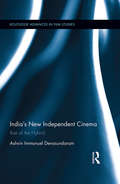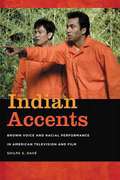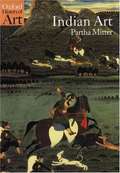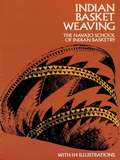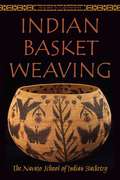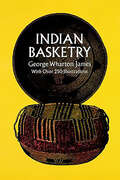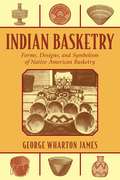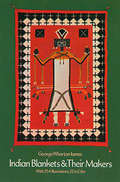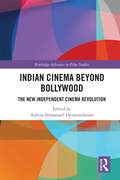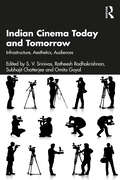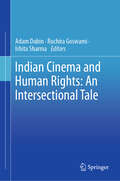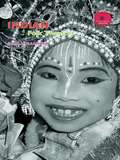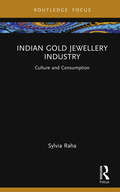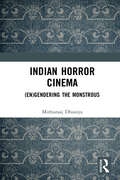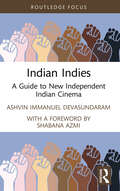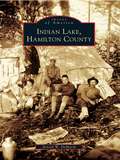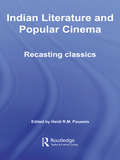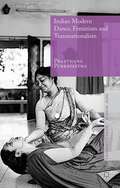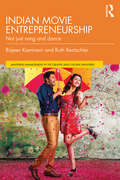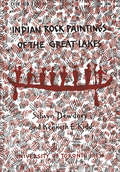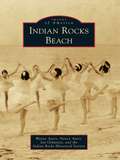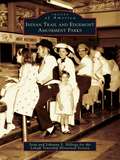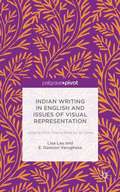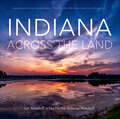- Table View
- List View
India's New Independent Cinema: Rise of the Hybrid (Routledge Advances in Film Studies)
by Ashvin Immanuel DevasundaramThis is the first-ever book on the rise of the new wave of independent Indian films that is revolutionising Indian cinema. Contemporary scholarship on Indian cinema so far has focused asymmetrically on Bollywood—India’s dominant cultural export. Reversing this trend, this book provides an in-depth examination of the burgeoning independent Indian film sector. It locates the new 'Indies' as a glocal hybrid film form—global in aesthetic and local in content. They critically engage with a diverse socio-political spectrum of ‘state of the nation’ stories; from farmer suicides, disenfranchised urban youth and migrant workers to monks turned anti-corporation animal rights agitators. This book provides comprehensive analyses of definitive Indie new wave films including Peepli Live (2010), Dhobi Ghat (2010), The Lunchbox (2013) and Ship of Theseus (2013). It explores how subversive Indies, such as polemical postmodern rap-musical Gandu (2010) transgress conventional notions of ‘traditional Indian values’, and collide with state censorship regulations. This timely and pioneering analysis shows how the new Indies have emerged from a middle space between India’s globalising present and traditional past. This book draws on in-depth interviews with directors, actors, academics and members of the Indian censor board, and is essential reading for anyone seeking an insight into a current Indian film phenomenon that could chart the future of Indian cinema.
Indian Accents: Brown Voice and Racial Performance in American Television and Film (The Asian American Experience)
by Shilpa S. DaveAmid immigrant narratives of assimilation, Indian Accents focuses on the representations and stereotypes of South Asian characters in American film and television. Exploring key examples in popular culture ranging from Peter Sellers' portrayal of Hrundi Bakshi in the 1968 film The Party to contemporary representations such as Apu from The Simpsons and characters in Harold and Kumar Go to White Castle, Shilpa S. Dave develops the ideas of "accent," "brownface," and "brown voice" as new ways to explore the racialization of South Asians beyond just visual appearance. Dave relates these examples to earlier scholarship on blackface, race, and performance to show how "accents" are a means of representing racial difference, national origin, and belonging, as well as distinctions of class and privilege. While focusing on racial impersonations in mainstream film and television, Indian Accents also amplifies the work of South Asian American actors who push back against brown voice performances, showing how strategic use of accent can expand and challenge such narrow stereotypes.
Indian Art
by Partha MitterThis concise yet lively new survey guides the reader through 5000 years of Indian art and architecture. A rich artistic tradition is fully explored through the Hindu, Buddhist, Islamic, Colonial, and contemporary periods, incorporating discussion of modern Bangladesh and Pakistan, tribalartists, and the decorative arts. Combining a clear overview with much fascinating detail, Mitter succeeds in bringing to life the true diversity of Indian culture. The influence of Islam on the Mughal court, which produced the world-famous Taj Mahal and exquisite miniature paintings is closely examined. More recently, he discussesthe nationalist and global concerns of contemporary art, including the rise of female artists, the stunning architecture of Charles Correa, and the vibrant art scene. The very particular character of Indian art is set within its cultural and religious milieu, raising important issues about the profound differences between Western and Indian ideas of beauty and eroticism in art.
Indian Art And Culture: For Civil Services And Other Competitive Examinations
by Nitin SinghaniaMcGraw-Hill is proud to present third edition of their bestseller “Indian art and Culture” by Nitin Singhania, third edition. This book offers comprehensive and latest information covering the broad field of knowledge on Indian art, paintings, music and architecture for the aspirants of Civil Services Preliminary and Main Examinations. Apart from two new chapters and one appendix, the chapters have been enriched with details to make it more focused and comprehensive. There are questions at the end of each chapter which will help students prepare for the examinations. Highlights: All new four colour edition, Comprehensive 4 sections: Visual arts, Performing arts, Culture of India and Appendices, New chapters on Buddhism and Jainism + India through the eyes of foreign travelers, New appendix on Current affairs related to Indian Art and Culture, Videos related to the chapters available through QR codes, Keywords in every chapter highlighted in color, Updated Previous Year Questions and Answers of UPSC Preliminary and Main Examination.
Indian Basket Weaving
by Navajo School of Indian BasketryThe methods of Indian basket weaving explained in this excellent manual are the very ones employed by native practitioners of the craft. members of the Navajo School of Basketry have set down their secrets in clear and simple language, enabling even the beginner to create work that can rival theirs in grace, design, and usefulness.Beginning with basic techniques, choice of materials, preparation of the reed, splicing, the introduction of color, principles and methods of design, shaping the basket and weaves from many cultures, such as Lazy Squaw, Mariposa, Taos, Samoan, Klikitat, and Shilo, each accompanied by specific instructions. There are suggestions for the weaving of shells, beads, feathers, fan palms, date palms, and even pine needles, and recipes for the preparation of dyes.Examples of each type of basket are illustrated by photographs, often taken from more than one angle so that the bottom can be seen as well as the top and sides. Close-up photography of the various types of stitching, especially at the crucial stage of beginning the basket, is an invaluable aid to the weaver. In addition, the authors have provided line drawings which are exceptionally clear magnifications of the various weave patterns.Anyone who follows the lessons contained in this book will have a knowledge of basketry unattainable in any other way. They are so lucid and complete that the amateur as well as the experienced weaver will be able to manufacture baskets distinguishable from authentic native articles only in that they were not woven by Indians. For those who merely seek a broader knowledge of American Indian arts, the book provides a comprehensive introduction to the subject of basketry.
Indian Basket Weaving: The Navajo School Of Indian Basketry
by The Navajo School of Indian BasketryThe methods of Indian basket weaving explained in this excellent manual are the very ones employed by native practitioners of the craft. Members of the Navajo School of Indian Basketry have set down their secrets in clear and simple language, enabling even the beginner to create work that can rival theirs in grace, design, and usefulness.The text begins with basic techniques: choice of materials, preparation of the reed, splicing, the introduction of color, principles and methods of design, shaping the basket and finishing. A great variety of baskets and weaves from many cultures are described in subsequent chapters, such as Lazy Squaw, Mariposa, Toas, Samoan, Klikitat, and Shilo, each accompanied by specific instructions. There are suggestions for the weaving of shells, beads, feathers, fan palms, date palms, and even pine needles, and recipes for the preparation of dyes.Examples of each type of basket are illustrated by photographs, often taken from more than one angle so that the bottom can be seen as well as the top and sides. Close-up photography of the various types of stitching, especially at the crucial stage of beginning the basket, is an invaluable aid to the weaver. In addition, the authors have provided line drawings which are exceptionally clear magnifications of the various weave patterns.Anyone who follows the lessons contained in this book will have a knowledge of basketry unattainable in any other way. They are so lucid and complete that the amateur as well as the experienced weaver will be able to manufacture baskets distinguishable from authentic native articles only in that they were not woven by Indians. For those who merely seek a broader knowledge of American Indian arts, the book provides a comprehensive introduction to the subject of basketry.
Indian Basketry
by George W. JamesSince it first publication in 1901, this pioneering study by George Wharton James, once a leading collector and authority, has become a valuable source book for American Indian basketry. From Poma mush baskets to Paiute dicing trays, Indian Basketry traces the origin, development, and fundamental principles of Indian basket designs for the major tribal units in Southwestern United States and Pacific Coast, with occasional comments on the basket weaving of a number of other North American tribes.Author of several books on the Southwest, George James has used his extensive experience in the field to compile indispensable information (much gathered directly through interviews with Indian basketmakers) covering nearly every aspect of Indian basketry: esthetics, designs, dyes, and coloration, weaving and stitching techniques (including the bamtush and dah-lah methods), basket types, tribal variation, and functional considerations, offering clear instructions for those who may be interested in reproducing these ancient American crafts. James also includes a description of various native weaving materials such as pine root, bark, sumac, willow, twigs, fern stalks, grass and palm fronds, with suggestions regarding the ways in which the Indians wove shells, feathers, beads, leather, and pine needles into their basket designs.The book is a valuable aid for the artist, designer, and craftsman, or even for the beginner, who may wish to re-create authentic and often extinct basket forms and decorative motifs. It is also most useful to the collector, cultural historians, ethnologist, scholar, or buff, who desires to know more about specific aspects of Indian basketry, or about Indian arts in general. As an important contribution to the historiography of American Indian culture, this may be one of the most practical Indian basketry books that you could own.
Indian Basketry: Forms, Designs, and Symbolism of Native American Basketry
by George Wharton JamesEverything there is to know about traditional Native American basket weaving.Native American basket weaving is an intricate and powerful art, representative of the legends and ceremonies of the Indian nations and their cultures. George Wharton James's Indian Basketry is an invaluable aid for the artist, designer, craftsman, or beginner who wants to recreate authentic and often extinct basket forms and decorative motifs of the Native American peoples.Filled with 355 illustrations and photographs of Native American basket weavers taken at the turn of the twentieth century, this pioneering study-first published in 1901-provides in-depth information about specific aspects of Indian basketry, including: Its role in legend and ceremony The origins of forms and designs Materials and colors used Weaves and stitches The symbolism and poetry woven into each basket Preservation Tips for the collector And much more!From Yolo ceremonial baskets to Oraibi sacred trays, Indian Basketry traces the origin, development, and fundamental principles of the basket designs of the major Indian tribes of the southwestern United States and Pacific Coast, along with comments on the basket weaving of a number of other North American tribes.
Indian Blankets and Their Makers
by George Wharton JamesHistory, old-style wool blankets, changes brought about by traders, symbolism of design and color, a Navajo weaver at work, more. Emphasis on Navajo. Includes information on the Bayeta blanket, squaw dresses, dyeing, belts, garters, hair braids, imitation blankets, the Chimayó blanket, and reliable dealers. 254 illustrations, 32 in color.
Indian Cinema Beyond Bollywood: The New Independent Cinema Revolution (Routledge Advances in Film Studies)
by Ashvin Immanuel DevasundaramThis is the first edited volume on new independent Indian cinema. It aims to be a comprehensive compendium of diverse theoretical, philosophical, epistemological and practice-based perspectives, featuring contributions from multidisciplinary scholars and practitioners across the world. This edited collection features analyses of cutting-edge new independent films and is conceived to serve as a beacon to guide future explorations into the burgeoning field of new Indian Cinema studies.
Indian Cinema Today and Tomorrow: Infrastructure, Aesthetics, Audiences
by S. V. Srinivas, Ratheesh Radhakrishnan, Subhajit Chatterjee, and Omita GoyalCinema has been, and is, a powerful tool for social mobilisation. The political importance of cinema was of course always well-known and has continued to evolve and grow. However, with innovations in modern technology, there has been the exponential growth of television alongside the movies, with content made especially for TV, as well as social media.This volume covers developments in Indian Cinema over the last decade. It explores an array of changes which has dramatically changed cinema — a surge of new filming and broadcasting technologies, from the camera phone to the most sophisticated digital equipment; an avalanche of talent, from trained to completely untrained actors; and a volume of content difficult to document and categorise. It also studies cinema growth and reactions to the onslaught of home entertainment and discusses its changing formats over the years, from TV to satellite, to VCRs and DVDs, serials to OTT streaming platforms.This book will be of great interest to scholars and researchers in film studies, performance studies, cultural studies, media studies, and popular culture. It will also interest professionals working in media and entertainment industries.
Indian Cinema and Human Rights: An Intersectional Tale
by Adam Dubin Ruchira Goswami Ishita SharmaThis book examines the intersection between Indian cinema (across geographic regions, languages and formats) and human rights. It analyzes Indian cinema from multiple human rights perspectives, such as freedom of expression and censorship, socio-economic rights, caste rights, women's and children's rights and LGBTQIA+ equality. The book bridges human rights law and cinema studies, and opens up new research areas within sociocultural and socio-legal academic contexts. It also contributes to academic disicplines beyond Law and Cinema, including Media, Cultural, Gender, Socio-economic and Sociology studies and is relevant for Liberal Arts curricula, Law Schools and as a reference book in university libraries in India and internationally, especially in film institutes. Finally, the book offers practical implications for human rights activists and policymakers by exploring how rights can be advanced through cinema and pop culture.
Indian Folk Theatres
by Julia HollanderIndian Folk Theatres is theatre anthropology as a lived experience, containing detailed accounts of recent folk theatre shows as well as historical and cultural context. It looks at folk theatre forms from three corners of the Indian subcontinent: Tamasha, song and dance entertainments from Maharastra Chhau, the lyrical dance theatre of Bihar Theru Koothu, satirical, ritualised epics from Tamil Nadu. The contrasting styles and contents are depicted with a strongly practical bias, harnessing expertise from practitioners, anthropologists and theatre scholars in India. Indian Folk Theatres makes these exceptionally versatile and up-beat theatre forms accessible to students and practitioners everywhere.
Indian Gold Jewellery Industry: Culture and Consumption (Routledge Focus on Management and Society)
by Sylvia RahaIndia has a long-standing cultural and societal affinity with gold and gold jewellery. Gold metaphorically represents the sacredness, purity and immortality that bind religious beliefs and culture together. Accumulation of gold is associated with material and non-material cultures where the perceptions, attitudes and experiences of the members engaged in production and consumption are bound into a complex relationship. The idea of the book initially originated from the course of research work. It was found that India has the largest unorganised jewellery industry, in terms of manufacturing and consumption unit. Jewellery fabrication in India is not just a profession for the jewellers, but it has been a family tradition extending across generations. Gold jewellery makers (sunnar, swarnakars) are the spine of the jewellery industry. They acquired the skill of making jewellery from the experienced and learned gold smithery (karigars), either from their ancestors who were engaged in this business or from the craftsmen-cum-petty traders. The co-relations of castes, religion, culture, economy and class are intertwined with each other in such a way that made the gold jewellery industry sustainable. Surprisingly, there is an absence of literature on understanding the structural and functional aspects of the gold jewellery industry in India.This book explores the roles of sunars/swarnakars (goldsmith or jewellery makers), consumers, trade and the policies that bring a change in the gold jewellery industry in India and India’s position in the global market scenario. By focusing on their way of life, the book brings unique insights into the social and economic experience of the unorganised gold jewellery sector and the role of consumers in production.
Indian Horror Cinema: (En)gendering the Monstrous
by Mithuraaj DhusiyaThis book studies the hitherto overlooked genre of horror cinema in India. It uncovers some unique and diverse themes that these films deal with, including the fear of the unknown, the supernatural, occult practices, communication with spirits of the deceased, ghosts, reincarnation, figures of vampires, zombies, witches and transmutations of human beings into non-human forms such as werewolves. It focusses on the construction of feminine and masculine subjectivities in select horror films across seven major languages – Hindi, Tamil, Telugu, Kannada, Bangla, Marathi and Malayalam. The author shows that the alienation of the body and bodily functions through the medium of the horror film serves to deconstruct stereotypes of caste, class, gender and anthropocentrism. Some riveting insights emerge thus, such as the masculinist undertow of the possession narrative and how complex structures of resistance accompany the anxieties of culture via the dread of laughter. This original account of Indian cinematic history is accessible yet strongly analytical and includes an exhaustive filmography. The book will interest scholars and researchers in film studies, media and cultural studies, art, popular culture and performance, literature, gender, sociology, South Asian studies, practitioners, filmmakers as well as cinephiles.
Indian Indies: A Guide to New Independent Indian Cinema (Routledge Focus on Film Studies)
by Ashvin Immanuel DevasundaramThis book offers a concise and cutting-edge repository of essential information on new independent Indian films, which have orchestrated a recent renaissance in the Bollywood-dominated Indian cinema sphere. Spotlighting a specific timeline, from the Indies’ consolidated emergence in 2010 across a decade of their development, the book takes note of recent transformations in the Indian political, economic, cultural and social matrix and the concurrent release of unflinchingly interrogative and radically evocative films that traverse LGBTQ+ issues, female empowerment, caste discrimination, populist politics and religious violence. A combination of essential Indie-specific information and concise case studies makes this a must-have quick guide to the future torchbearers of Indian cinema for scholars, students, early career researchers and a global audience interested in intersecting aspects of cinema, culture, politics and society in contemporary India.
Indian Lake, Hamilton County (Images of America)
by Arnold W. DemarshThe village of Indian Lake was formally founded in 1858, during a time when many small communities were springing up in the Adirondacks as a result of the lumber industry. In 1889, Dr. Thomas C. Durant established a branch of the Delaware and Hudson Railroad that connected Saratoga Springs and North Creek. Through the later part of the 19th century and early-20th century, the Adirondack Mountains became a paradise destination for the rich and famous. Indian Lake, which began as a stopover for Blue Mountain Lake and Raquette Lake, quickly grew into a tourist center in its own right because of its ideal location and beauty. Indian Lake, Hamilton County is a pictorial journey through the golden age of this region, a haven of beauty and nature.
Indian Literature and Popular Cinema: Recasting Classics (Routledge Contemporary South Asia Series)
by Heidi R.M.PauwelsThis book is about the popular cinema of North India ("Bollywood") and how it recasts literary classics. It addresses questions about the interface of film and literature, such as how Bollywood movies rework literary themes, offer different (broader or narrower) interpretations, shift plots, stories, and characters to accommodate the medium and the economics of the genre, sometimes even changing the way literature is read. This book addresses the socio-political implications of popular reinterpretations of "elite culture", exploring gender issues and the perceived "sexism" of the North Indian popular film and how that plays out when literature is reworked into film. Written by an international group of experts on Indian literature and film, the chapters in this book focus on these central questions, but also cover a wide range of literary works that have been adapted in film. Each part of the book discusses how a particular genre of literature has been "recast" into film. The individual chapters focus on comparisons and close studies of individual films or film songs inspired by "classics" of literature. The book will be of interest to those studying Indian film and literature and South Asian popular culture more generally.
Indian Modern Dance, Feminism and Transnationalism
by Prarthana PurkayasthaThis book examines modern dance as a form of embodied resistance to political and cultural nationalism in India through the works of five selected modern dance makers: Rabindranath Tagore, Uday Shankar, Shanti Bardhan, Manjusri Chaki Sircar and Ranjabati Sircar.
Indian Movie Entrepreneurship: Not just song and dance (Discovering the Creative Industries)
by Ruth Rentschler Rajeev KamineniOne of the world’s most prolific creative industries, the Indian movie industry has received scant attention for its spirit of enterprise. Indian Movie Entrepreneurship addresses this omission. For many readers, it might come as a surprise that the Indian movie industry is not just Bollywood and that it has several regional clusters, which are just as vibrant, with a significant output. The authors begin by outlining the contours of Indian cinema and the different regional language hubs that form part of the larger picture. The reader is then offered a glimpse into the actual process of making a film from day zero to release day. The key players in the Indian movie ecosystem are analysed, with the central role of the producer highlighted. Concluding with a look into the future of the entrepreneurial process in the Indian movie industry, the authors illuminate the shifting parameters of distribution and exhibition. Appealing to those interested in understanding the entrepreneurial journey of the Indian movie industry, the book provides a sneak peek into the business landscape of India more broadly.
Indian Rock Paintings of the Great Lakes (Quetico Foundation series #4)
by Selwyn Dewdney Kenneth E. KiddThis book describes in word and illustration the results of an exciting quest on the part of its authors to discover and record Indian rock paintings of Northern Ontario and Minnesota. Numerous drawings were made from these pictographs at a hundred different sites; the originals range in age from four to five hundred years to a thousand, and were done with the simplest materials: fingers for brushes, fine clay impregnated with ferrous oxide giving the characteristic red paint. Where an overhanging rock protected a vertical face from dripping water or on dry, naked rock faces the Indians recorded the forest life with which they lived in intimate association—deer, caribou, rabbit, heron, trout, canoes, animal tracks—and also abstractions which puzzle and intrigue the modern viewer. Many of the paintings could only have been done from a canoe or a convenient rock ledge.<P><P> Selwyn Dewdney travelled many thousands of miles by canoe to make the drawings of the pictographs which illustrate every page of this fascinating and attractive book. He provides also a general analysis of the materials used by the Indians, of their subject-matter and the artistic rendering given to it, and his artist's journal records in detail the sites he visited, the paintings he found at each, the comparisons among them that came to mind, the references to rock paintings in early literature of the Northwest. Kenneth E. Kidd contributes a valuable essay on the anthropological background of the area, linking the rock paintings with early cave art in, for example, France and Spain, describing the life of the Indians in the Shield country, and commenting on what the pictographs reveal of their makers' attitudes to their external world and of their thinking.<P> This is a book which will appeal to a wide audience: to those interested in primitive art forms and in Canadian art in general, to all students of the early history of North America, to travellers who in increasing numbers follow the canoe trails of the Shield lakes and rivers.
Indian Rocks Beach (Images of America)
by Wayne Ayers Nancy Ayers Jan Ockunzzi Indian Rocks Historical SocietyAccording to legend, Indian Rocks got its name when Tocobaga Indians brought their ailing chief from inland Florida to drink from the area's sulfur springs, prized for their medicinal qualities. Their leader miraculously recovered, as the story goes, and the tribe returned each year to the place where large rocks surrounded the healing spring. The natural beauty of the barrier island that became Indian Rocks Beach was what attracted Harvey Hendrick to establish his homestead here in the mid-1890s. Years later, he recalled, "I liked the place, I thought it was the most beautiful place on God's green footstool, and I think so yet." The charm and character of this little seaside community is evident in these historic photographs, from the days when the old swing bridge was the center of activity, to the booming post-World War II era when tourists and residents proclaimed Indian Rocks Beach as their special place.
Indian Trail and Edgemont Amusement Parks (Images of America)
by Lehigh Township Historical Society Johanna S. Billings Sean BillingsIndian Trail and Edgemont Amusement Parks highlights the history of two legendary amusement parks in Lehigh Township. Unique images cover Indian Trail Park from its founding by Samuel and William Solliday in 1929 to its closing in 1984. Photographs of Edgemont Park recall its days as a trolley park, started by the Blue Ridge Traction Company. These images are sure to bring back memories of the rides, games, and thrills that kept people coming back year after year.
Indian Writing in English and Issues of Visual Representation: Judging More Th an a Book by Its Cover
by E. Dawson Varughese Lisa LauThis book examines the use of book covers as marketing devices, asking what exactly they communicate to their readers and buyers, and what images they associate with a genre and create about a culture. Focusing on Indian women's writing in English, it combines the study of text with the study of materiality of the book.
Indiana Across the Land
by Lee Mandrell DeeDee Niederhouse-MandrellThe captivating landscapes of America's heartland offer an inviting escape from the everyday in Indiana Across the Land. Although a road trip from the shores of Lake Michigan to the Ohio River could be accomplished in only six hours, photographers Lee Mandrell and DeeDee Niederhouse-Mandrell take readers the long way around the Hoosier state, embarking on a breathtaking journey across the seasons, down windswept dunes, through old-growth forests, over burbling creeks and yawning chasms, past icy lighthouses and worn-down barns, and into the southern cypress swamps. More than 140 photographs capture the beauty of the Indiana Dunes National Lake Shore, Ouabache State Park, Turkey Run State Park, Squire Boone Caverns, and many other landmarks and natural wonders, both well-known and rarely glimpsed.
